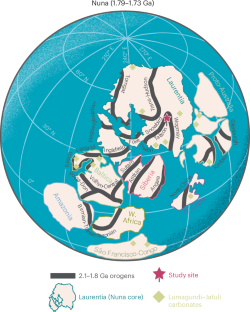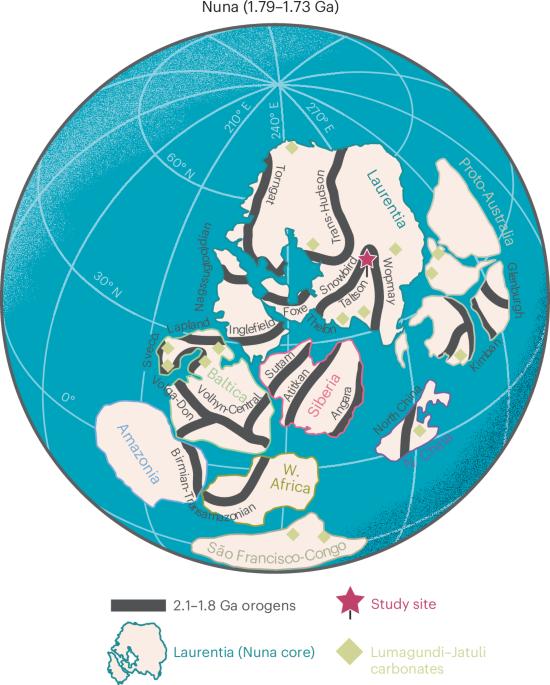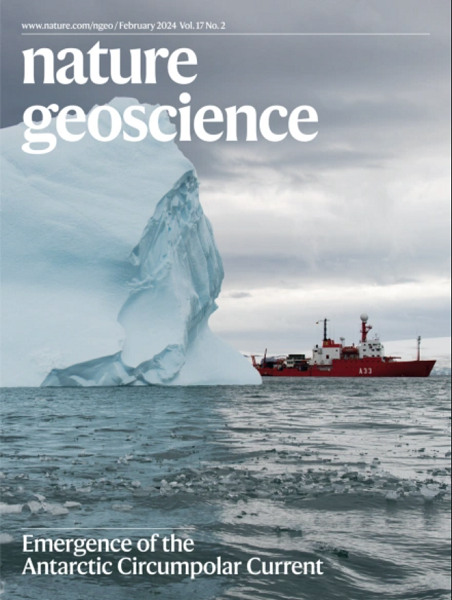Nuna supercontinent assembly linked to carbon cycling in shear zones 1.9–1.7 billion years ago
IF 15.7
1区 地球科学
Q1 GEOSCIENCES, MULTIDISCIPLINARY
引用次数: 0
Abstract
A peak in organic carbon burial approximately 2.1–1.8 billion years ago led to the prolific growth of graphite-rich orogens internal to the supercontinent Nuna. The temporal history of graphitic carbon in such orogens, however, is poorly understood, which limits our understanding of the timescales of carbon cycling during orogenesis. Here we examine the graphitic roots of two North American (Laurentian) orogens associated with Nuna supercontinent assembly using coupled rhenium–osmium and uranium–lead dating. These are the Taltson–Snowbird orogeny, approximately 1.94–1.89 billion years ago, and the Trans-Hudson orogeny, approximately 1.84–1.72 billion years ago. The geochronology results show that the studied graphite, hosted in shear zones, predominantly reflects biogenic carbon that was hydrothermally remobilized during the final exhumation stages of orogenesis approximately 1.92–1.67 billion years ago. Our results demonstrate that graphite deposition occurred with a periodicity of 31 ± 4 million years and probably involved carbon cycling on the scale of 50 million tonnes or more over a 200 million year interval. Comparisons with other contemporaneous shear zones suggests that late-orogenic, fluid-mediated graphite deposition was common among Laurentian, and more broadly Nuna, mountain belts. These findings imply that the mass movement of graphitic carbon is an endemic feature of the orogenic cycle. Graphitic carbon was hydrothermally cycled through shear zones during late-stage orogenesis associated with Nuna supercontinent assembly, according to a coupled rhenium–osmium and uranium–lead dating study.


19-17亿年前努纳超大陆的形成与剪切带的碳循环有关
大约21-18亿年前的有机碳埋藏高峰导致了超大陆努纳内部富含石墨的造山运动的蓬勃发展。然而,人们对此类造山运动中石墨碳的时间历史了解甚少,这限制了我们对造山运动中碳循环时间尺度的理解。在这里,我们利用铼-锇和铀-铅的耦合测年方法研究了与努纳超新陆组装相关的两个北美(劳伦特)造山运动的石墨根。它们分别是距今约19.4-18.9亿年的塔尔森-雪鸟造山运动和距今约18.4-17.2亿年的跨哈德逊造山运动。地质年代学结果表明,所研究的石墨赋存于剪切带中,主要反映了约19.2-16.7亿年前造山运动最后掘起阶段的水热再活化生物碳。我们的研究结果表明,石墨沉积的周期为 31 ± 4 百万年,在 2 亿年的时间跨度内,碳循环的规模可能达到或超过 5 千万吨。与其他同时代剪切带的比较表明,晚期成因、流体介导的石墨沉积在劳伦山脉带以及更广泛的努纳山脉带中很常见。这些发现意味着石墨碳的大规模移动是造山周期的一个特有特征。
本文章由计算机程序翻译,如有差异,请以英文原文为准。
求助全文
约1分钟内获得全文
求助全文
来源期刊

Nature Geoscience
地学-地球科学综合
CiteScore
26.70
自引率
1.60%
发文量
187
审稿时长
3.3 months
期刊介绍:
Nature Geoscience is a monthly interdisciplinary journal that gathers top-tier research spanning Earth Sciences and related fields.
The journal covers all geoscience disciplines, including fieldwork, modeling, and theoretical studies.
Topics include atmospheric science, biogeochemistry, climate science, geobiology, geochemistry, geoinformatics, remote sensing, geology, geomagnetism, paleomagnetism, geomorphology, geophysics, glaciology, hydrology, limnology, mineralogy, oceanography, paleontology, paleoclimatology, paleoceanography, petrology, planetary science, seismology, space physics, tectonics, and volcanology.
Nature Geoscience upholds its commitment to publishing significant, high-quality Earth Sciences research through fair, rapid, and rigorous peer review, overseen by a team of full-time professional editors.
 求助内容:
求助内容: 应助结果提醒方式:
应助结果提醒方式:


